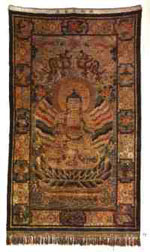Chinese Wool Carpets
 0 Comment(s)
0 Comment(s) Print
Print E-mail
asia-art.net, May 17, 2008
E-mail
asia-art.net, May 17, 2008

Large carpets, particularly those made of wool, were not used in China until relatively recent times. However, smaller carpets date back centuries.
Rugs to cover the ‘Kang,’ a brick fire-heated bed platform typical in north China started to be used during Ming (1368-1644) times. Most of these rugs were made of felt and camel hair, and they were dyed black and red at the borders. Chinese carpets of felt and silk might date back to the Tang dynasty (618-907).
During the Ming and Qing dynasties, woolen rugs for the Kang, temple floor mats, prayer rugs and wool hangings came from the northern border area of China, like Gansu, Suiyuan, Shansi and Shaanxi. Later, rugs came from Tibet and Mongolia as well as areas outside of Chinese control. Northern Shanxi, Suiyuan and Ningxia were all famous for the quality of their carpets. These rugs were predominantly made from wool and camel hair, both abundant in these areas.
From historical records, it appears that no wool looms were in use in Beijing until the very early 1860s. In 1860, a Buddhist priest named Ho Chi-ching started a weaving school at Paoku for poor people in Beijing. This proved successful and the school divided into a Western gate school and an Eastern gate school. Later, the Western gate school moved to Tianjin where it developed a tradition of making very durable camel wool carpets decorated with simple geometrical patterns in red, blue and brown yarn. In the late 1800s, the quality of rug-making had deteriorated markedly, and the Tianjin wool rug industry collapsed completely with the fall of the Qing dynasty. In the 1930s the rug industry was restarted in both Tianjin and Shanghai with the aid of Western capital.
Go to Forum >>0 Comment(s)